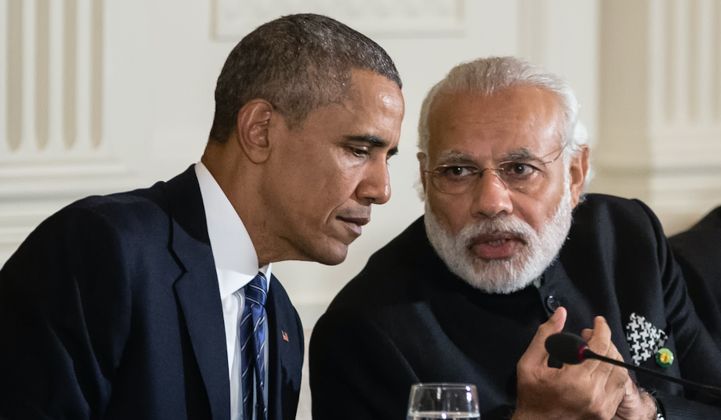This week, President Obama committed tens of millions of dollars toward off-grid solar projects in India -- a deal that American officials say could leverage $1 billion in total investment in the sector.
However, one of India’s top solar analysts is expressing caution about the deal.
“This sort of financing comes with a long and expensive due-diligence process," warned Jasmeet Khurana, associate director of solar consulting firm Bridge to India.
“International capital coming into India in any form is a welcome step. The sector could definitely use it. However, while the focus on off-grid solar projects and rural electrification may appear to be common sense, it may run into operational challenges," said Khurana.
In particular, he said, companies operating in the space may not be equipped to utilize the amount of money dedicated to the off-grid sector. "Their capacity addition plans, ticket size per investment, and the bankability of the investment itself, might not meet the criteria to ensure a meaningful utilization of the fund."
The financing package was unveiled during Indian Prime Minister Narendra Modi's visit to President Barack Obama in Washington. During the meeting, the two leaders focused on how to meet their climate goals outlined at last year's U.N. summit.
“The United States supports the government of India’s ambitious national goals to install 175 gigawatts of renewable power, which includes 100 gigawatts from solar power," said the White House in a joint statement.
As part of that support, the Obama administration committed to “a $40 million U.S.- India Catalytic Solar Finance Program, equally supported by the United States and India, that...could mobilize up to $1 billion of projects.”
The announcement follows a long history of support for U.S. solar interests in India -- resulting in the subcontinent being the only major PV market dominated by U.S.-produced thin film products.
Thin-film PV has a minority share in all other solar markets, but has thrived in India because it is exempt from India’s local-content requirement. And when imported from the U.S., it is supported by low-interest loans from the Export-Import Bank of the United States.
This financial advantage has helped U.S. thin film companies, and particularly the market leader First Solar, to make a killing in the Indian solar market. In March of this year, First Solar announced it had shipped a gigawatt worth of capacity to India.
That is equal to about one-fifth of the 5 gigawatts of cumulative installed capacity in India at the end of 2015, according to figures from the International Renewable Energy Agency.
However, extending this kind of money to the off-grid segment could present challenges. “India has a terrible record on providing reliable grid electricity to large parts of the country,” said Bridge to India in a blog post. “Several startups have enjoyed limited success in the mini- and microgrid sector but a scalable, profitable model seems to be elusive.”
Nevertheless, the Modi administration’s latest policy on minigrids and microgrids does address current challenges, for example by providing visibility into regulated prices or making it easier to get information on taxes and exemptions.
“The policy is still in draft stage and is meant as a guideline for states, which can adapt or modify the policy based on their local needs,” said Bridge to India this month. "It provides some much-needed policy certainty to the sector."
These concerns may not matter much at the White House. After all, the star of energy deal was not solar, but nuclear.
While America’s nuclear industry has suffered in recent years from low gas prices, India is forging ahead with an ambitious reactor program. The country “has a flourishing and largely indigenous nuclear power program and expects to have 14.6 gigawatts [of] nuclear capacity on-line by 2024 and 63 gigawatts by 2032,” reports the World Nuclear Association.
The White House hopes that India will become an important market for American nuclear companies.
“The leaders welcomed the start of preparatory work on site in India for six AP 1000 reactors to be built by Westinghouse and noted the intention of India and the U.S. Export-Import Bank to work together toward a competitive financing package for the project,” it said.
Those AP 1000 reactors cost around $3 billion apiece on the Chinese market. So while significant, the millions committed to off-grid solar in India still represent only a fraction of the deal's value.



